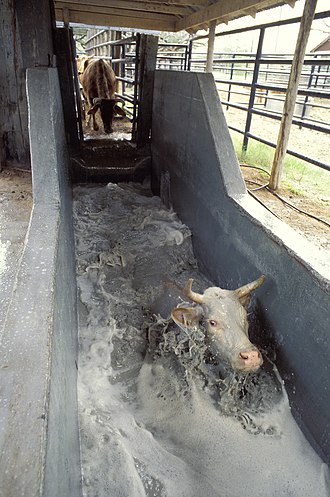Plunge dip


Plunge dip is a method used in veterinary medicine for the treatment and prevention of ectoparasites in livestock. This technique involves immersing animals in a specially designed tank filled with a chemical solution that kills parasites such as ticks, mites, and lice. Plunge dipping is commonly used for cattle, sheep, and goats.
History[edit]
The practice of plunge dipping dates back to the late 19th century when it was developed as a means to control tick-borne diseases in livestock. The method gained popularity due to its effectiveness in eradicating parasites and improving the overall health of animals.
Procedure[edit]
The plunge dip tank is typically a long, narrow structure filled with a pesticide solution. Animals are driven through the tank, ensuring that their entire bodies are submerged in the solution. The process usually involves the following steps:
- Preparation: The dip tank is filled with a pesticide solution, mixed according to the manufacturer's instructions.
- Dipping: Animals are guided into the tank one by one. They are fully submerged to ensure that the solution reaches all parts of their bodies.
- Draining: After exiting the tank, animals are allowed to drain off excess solution in a designated area.
- Monitoring: Animals are monitored for any adverse reactions to the pesticide.
Advantages[edit]
- Effective Control: Plunge dipping is highly effective in controlling a wide range of ectoparasites.
- Cost-Effective: It is a cost-effective method for treating large numbers of animals.
- Comprehensive Coverage: Ensures that the entire body of the animal is treated, reducing the risk of missed spots.
Disadvantages[edit]
- Stressful for Animals: The process can be stressful for animals, particularly if not handled properly.
- Chemical Exposure: There is a risk of chemical exposure to both animals and handlers.
- Environmental Impact: Improper disposal of used dip solutions can lead to environmental contamination.
Safety Measures[edit]
To ensure the safety of both animals and handlers, the following measures should be taken:
- Use protective clothing and equipment.
- Follow the manufacturer's instructions for mixing and handling the pesticide solution.
- Ensure proper ventilation in the dipping area.
- Dispose of used dip solutions according to local regulations.
Related Pages[edit]
Categories[edit]

This veterinary medicine related article is a stub. You can help WikiMD by expanding it.
Ad. Transform your life with W8MD's Budget GLP-1 injections from $75


W8MD offers a medical weight loss program to lose weight in Philadelphia. Our physician-supervised medical weight loss provides:
- Weight loss injections in NYC (generic and brand names):
- Zepbound / Mounjaro, Wegovy / Ozempic, Saxenda
- Most insurances accepted or discounted self-pay rates. We will obtain insurance prior authorizations if needed.
- Generic GLP1 weight loss injections from $75 for the starting dose.
- Also offer prescription weight loss medications including Phentermine, Qsymia, Diethylpropion, Contrave etc.
NYC weight loss doctor appointmentsNYC weight loss doctor appointments
Start your NYC weight loss journey today at our NYC medical weight loss and Philadelphia medical weight loss clinics.
- Call 718-946-5500 to lose weight in NYC or for medical weight loss in Philadelphia 215-676-2334.
- Tags:NYC medical weight loss, Philadelphia lose weight Zepbound NYC, Budget GLP1 weight loss injections, Wegovy Philadelphia, Wegovy NYC, Philadelphia medical weight loss, Brookly weight loss and Wegovy NYC
|
WikiMD's Wellness Encyclopedia |
| Let Food Be Thy Medicine Medicine Thy Food - Hippocrates |
Medical Disclaimer: WikiMD is not a substitute for professional medical advice. The information on WikiMD is provided as an information resource only, may be incorrect, outdated or misleading, and is not to be used or relied on for any diagnostic or treatment purposes. Please consult your health care provider before making any healthcare decisions or for guidance about a specific medical condition. WikiMD expressly disclaims responsibility, and shall have no liability, for any damages, loss, injury, or liability whatsoever suffered as a result of your reliance on the information contained in this site. By visiting this site you agree to the foregoing terms and conditions, which may from time to time be changed or supplemented by WikiMD. If you do not agree to the foregoing terms and conditions, you should not enter or use this site. See full disclaimer.
Credits:Most images are courtesy of Wikimedia commons, and templates, categories Wikipedia, licensed under CC BY SA or similar.
Translate this page: - East Asian
中文,
日本,
한국어,
South Asian
हिन्दी,
தமிழ்,
తెలుగు,
Urdu,
ಕನ್ನಡ,
Southeast Asian
Indonesian,
Vietnamese,
Thai,
မြန်မာဘာသာ,
বাংলা
European
español,
Deutsch,
français,
Greek,
português do Brasil,
polski,
română,
русский,
Nederlands,
norsk,
svenska,
suomi,
Italian
Middle Eastern & African
عربى,
Turkish,
Persian,
Hebrew,
Afrikaans,
isiZulu,
Kiswahili,
Other
Bulgarian,
Hungarian,
Czech,
Swedish,
മലയാളം,
मराठी,
ਪੰਜਾਬੀ,
ગુજરાતી,
Portuguese,
Ukrainian